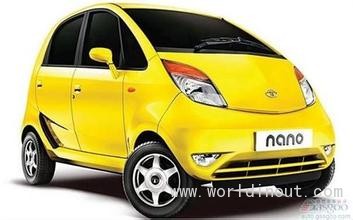
The car emerged at a much -anticipated launch on Thursday: a cute, short thing, with four doors, tiny wheels placed out at the far corners of the body and what looked like plenty of room inside. The Nano has just enough space for a briefcase or small bag under the hood. The engine — all two cylinders, 624cc and 33 horsepower of it 一 is in the back, just like the Volkswagen Beetle of old. The speedometer1 and other instruments cluster in a central pod in the middle of the dashboard rather than directly in front of the driver, the easier (and cheaper) to offer both left- and right-hand versions when Tata Motors starts exporting the car to Southeast Asia and Africa in a couple of years. It has a top speed of about 60 miles per hour. “Car companies are in probably the most emotive business area that one can find apart from fashion,” company chairman Ratan Tata told TIME a day before the big launch. “There will be people who say it looks like a toy, but if you consider the value proposition I think the car isgreat.”
Tata hopes the Nano will help millions of poor people around the world 一 the “Bottom of the Pyramidw in developing world marketing-speak — switch from two wheels to four. Environmentalists, city planners and even some competitors, on the other hand, warn that the new vehicle will clog up2 India’s crowded roads and add clouds of pollution to its already filthy air.
Ratan Tata emphasized that the new car complies with India’s emissions laws and even with Europe’s much stronger Euro 4 standards. Emissions, Tata says, are “lower than a scooter*s today”. The company claims the car will also deliver 50 miles per gallon, or better than 20 kilometers per liter, which would make it one of India’s most efficient vehicles, and vastly more efficient than the average in the U.S. Chief U.N. climate scientist Rajendra Pachauri, who shared last year’s Nobel Peace Prize with Al Gore, said recently that he was “having nightmares” about the low-cost car. “Dr. Pachauri need not have nightmares,” said Ratan Tata at today’s unveiling. “For us it’s a milestone and I hope we can make a contribution to the country.”
But with India’s road infrastructure struggling to keep up with explosive growth in car sales, won’t the new Tata just add to the country*s road hassles3? That’s a problem the Indian government has to deal with, not manufacturers, Tata said.
“We’d certainly be concerned if our vehicle created absolute chaos4 all across India,” he told one questioner who complained that his morning journey of a few miles across Delhi took over anhour. “But if you had chaos today and it did not include our vehicles, then 丨 would suggest the problem has to do with something else besides the presence or absence of our vehicles,” India, he agreed, “does desperately need mass transit systems... both within citiesand between cities,M But poor Indian families also have a right to what millions take for granted elsewhere in the world. “Should they be denied the right to independent transport?”
Eventually, Tata Motors hopes to sell a million Nanos a year. Even before it goes on sale, though, it has become an important symbol of an emerging trend in the developing world, a new brand of innovation that makes more out of less and engineers clever but cheap fixes to problems that Western companies might throw expensive technology at.
The head of the Nano team says Tata Motors has applied for 34 patents5 on various components and design features on the new car, though he was short on specifics. The car reportedly uses super strong glue rather than welds in some joints — a technique that a handful of other car makers have used before, though perhaps never as extensively. Tata Motors,cost-cutting drive was relentless: the windshield has just one washer rather than two, the metal steering column was hollowed out to save on steel, cheaper bearings. Given the steep rise in the cost of steel, rubber and other inputs in the past few years, it’s possible that the entry level Nano might not break even, though Tata made a point of saying the “one lakh” price tag in India will stay because “a promise is a promise”. Ratan Tata said